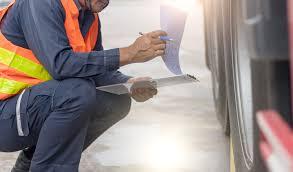Commercial Vehicle Safety Alliance CVSA Driver Tip Sheet

From a commercial vehicle safety inspector’s perspective, the point of the NAS inspection is to ensure both your safety and those of others traveling on the highways. The costs associated with being put out of service are insignificant when compared to the costs of crashes with innocent people. Be proactive and inspect your vehicle thoroughly before you take your next trip. The keys are in your hand.
1. BRAKES
Check for missing, non-functioning, loose, contaminated or cracked parts on the brake system; Check for “S” cam flip-over; Be alert for audible air leaks around brake components and lines; Check that the slack adjusters are the same length (from center of “S” cam to center of clevis pin), and that the air chambers on each axle are the same size. Check brake adjustment; Ensure the air system maintains air pressure between 90 and 100 psi; Measure pushrod travel; Inspect required brake system warning devices, such as ABS malfunction lamps and low air pressure warning devices;
Inspect tractor protection system, including the bleedback system on the trailer.
2. COUPLING DEVICES
Safety Devices-Full Trailers/Converter Dolly(s): Check the safety devices (chains/wire rope) for sufficient number, missing components, improper repairs, and devices that are incapable of secure attachment. On the Lower Fifth Wheel check for unsecured mounting to the frame or any missing or damaged parts; or any visible space between the upper and lower fifth wheel plates. Verify that the locking jaws are around the shank and not the head of the kingpin and that the release lever is seated properly and that the safety latch is engaged. Check the Upper Fifth Wheel for any damage to the weight bearing plate (and its supports) such as cracks, loose or missing bolts on the trailer. On the Sliding Fifth Wheel check for proper engagement of locking mechanism (teeth fully engaged on rail); also check for worn or missing parts, ensure that the position does not allow the tractor frame rails to contact the landing gear during turns. Check for damaged or missing fore and aft stops.
3. FUEL & EXHAUST SYSTEMS
Check your fuel tanks for the following conditions: Loose mounting, leaks, or other conditions; loose or missing caps; and signs of leaking fuel below the tanks. For exhaust systems, check the following: Unsecured mounting; leaks beneath the cab; exhaust system components in contact with electrical wiring or brake lines and hoses; and excessive carbon deposits around seams and clamps.
4. FRAME, VAN & OPEN-TOP TRAILERS
Inspect for corrosion fatigue, cross member(s) cracked, loose or missing, cracks in frame, missing or defective body parts. Look at the condition of the hoses, check suspension of air hoses of vehicle with sliding tandems. On the frame and frame assembly check for cracks, bends, sagging, loose fasteners or any defect that may lead to the collapse of the frame; corrosion, fatigue, cross members cracked or missing, cracks in frame, missing or defective body parts. Inspect all axle(s). Inspect for non-manufactured holes (i.e. rust holes, holes created by rubbing or friction, etc.), for broken springs in the spring brake housing section of the parking brake. For vans and open-top trailer bodies, look at the upper rail and check roof bows and side posts for buckling, cracks, or ineffective fasteners. On the lower rail, check for breaks accompanied by sagging floor, rail, or cross members; or broken with loose or missing fasteners at side post adjacent to the crack.
5. LIGHTING
Inspect all required lamps for proper color, operation, mounting and visibility.
6. SECUREMENT OF CARGO
Make sure you are carrying a safe load. Check tail board security. Verify end gates are secured in stake pockets. Check both sides of the trailer to ensure cargo is protected from shifting or falling. Verify that rear doors are securely closed. Where load is visible, check for proper blocking and bracing. It may be necessary to examine inside of trailer to assure that large objects are properly secured. Check cargo securement devices for proper number, size and condition. Check tie down anchor points for deformation and cracking.
7. STEERING
Check the steering lash by first turning the steering wheel in one direction until the tires begin to pivot. Then, place a mark on the steering wheel at a fixed reference point and then turn the wheel in the opposite direction until the tires again start to move. Mark the steering wheel at the same fixed reference point and measure the distance between the two marks. The amount of allowable lash varies with the diameter of the steering wheel.
8. SUSPENSION
Inspect the suspension for: Indications of misaligned, shifted, cracked or missing springs; loosened shackles; missing bolts; unsecured spring hangars; and cracked or loose U-bolts. Also, check any unsecured axle positioning parts and for signs of axle misalignment. On the front axle, check for cracks, welds and obvious misalignment.
9. TIRES, WHEELS, RIMS & HUBS
Check tires for proper inflation, cuts and bulges, regrooved tires on steering axle, tread wear and major tread groove depth. Inspect sidewalls for defects, improper repairs, exposed fabric or cord, contact with any part of the vehicle, and tire markings excluding it from use on a steering axle. Inspect wheels and rims for cracks, unseated locking rings, and broken or missing lugs, studs or clamps. Also check for rims that are cracked or bent, have loose of damaged lug nuts and elongated stud holes, have cracks across spokes or in the web area, and have evidence of slippage in the clamp areas. Check the hubs for lubricant leaks, missing caps or plugs, misalignment and positioning, and damaged, worn or missing parts.
If you are put out of service, it will cost you $861 on average — which ! does not include the costs of fines or repairs as a result of the inspection.






